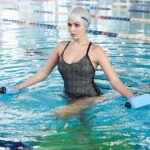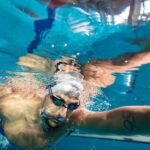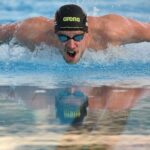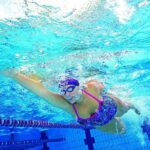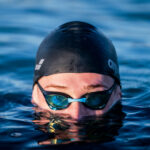Learn How to Turn: Flip Turn Drills for Faster Swimming
The flip turn is a vital swimming technique that can increase your speed and efficiency. It might seem difficult for beginners, but once you get the hang of the proper form, the flip turn will become your best friend — from practice to competitive swimming.
Today, we will cover everything you need to know about performing the flip turn with proper technique. We’ll look into each element involved in the flip turn and give one drill you can practice for each stage of the flip turn. After that, we will go over some common mistakes and how you can avoid them. Finally, we’ll touch on a few dryland exercises you can practice to improve your core and leg strength so you can have strong and fast turns.
Flip Turn Drills and Proper Mechanics

The flip turn is used by backstroke and freestyle swimmers during practice and competition. It is the most efficient way to push off the wall into your next lap. Whether you’re swimming long-distance events or sprints, a good flip turn will allow you to swim faster. Another benefit of the flip turn is that the motion expends less energy than the open turn used in breaststroke and butterfly, allowing you to focus more energy on your swim stroke.
It’s a good idea to focus on the fundamentals so you can learn the proper form or find areas to improve in so you can increase your flip turn progression. Below are some essential tips and drills that will help you master the flip turn.
Become Familiar With Approaching the Wall
Understanding where you are relative to the wall is important when performing the flip turn. For those who swim freestyle, or front crawl, the “T” at the end of the swimming line on the bottom of the pool is there to give you a heads up that the wall is coming. For backstrokers, the flags will let you know when you are nearing the wall.
Both freestyle swimmers and backstroke swimmers will need to practice timing out how long it takes to reach the wall from the “T” or from the flags. Practice your timing coming into the wall after you spot the “T.” Backstrokers will need to know their stroke count from spotting the flags to when they need to turn over to perform their tumble turn. It is usually 3-4 strokes but can vary from person to person.
Drill #1: Glide Into the Wall
This drill will help you get your timing down so you are comfortable carrying speed into your flip turns.
Practice swimming toward the wall at a good pace like you are finishing a race. Spot the “T.” Leave one arm extended in front of you and glide into the wall until your hand makes contact.
Practice this drill to get a feel for the distance from where you spot the “T” to touching the wall. This will help you familiarize yourself with your timing and the distance to the wall so you can execute your flip turn at the right moment.
Backstrokers should start by getting their stroke count from the flag but can perform the above drill in the same fashion from the point they roll onto their stomach.
Perform the “Flip”

Now comes the part where the turn gets its name. You will be performing a somersault, or flip, ending with both your feet planted firmly against the wall, ready to push off into the next lap.
To do this, take your final stroke when you are directly above the “T.” Let your hand come to your side, and with both hands next to your hips, tuck your chin in and bend at your hips. After this maneuver, you’ll need to finish the somersault motion by flipping your legs over and onto the wall. Contract your abdomen to aid in flipping your legs over. Bend your knees, and try to keep them above the surface of the water to reduce drag.
Don’t use your arms to aid in the flip. You should be able to complete the turn from the momentum coming into the wall, bending at your hips, and flipping your legs over. Your arms should remain still during the whole flip and come into the streamline position in front of your head when your feet are on the wall. In this position, you should be facing the surface of the pool.
Drill #2: Hold a Kickboard in Each Hand
This drill will help you get a feel for the somersault motion at the right level in the water. It will also help keep you from using your hands through your turn.
For this drill, you need to start on the wall so you can push off of it into a glide. Kick off the wall in a position with both hands by your sides and holding the kickboards. The palms of your hands should be facing up.
Start the flip as if you were doing a turn. You will not be performing this drill coming into the wall, so imagine planting your feet after the turn to maintain the proper body position.
Your hands and arms should not move much throughout the movement. The kickboards will force your hands to remain inactive during the flip turn motion. They will also provide buoyancy so you can get a feeling for keeping your knees out of the water during your turn.
Push Off, Streamline, and Dolphin Kick
The next part of the flip turn is pushing off into your next lap. To start, you need to make sure your feet are planted firmly against the wall after completing your flip turn. With your feet planted against the wall, you should be facing up toward the surface of the water.
Next, push firmly off the wall, driving evenly through both legs. Backstroke swimmers will stay on their backs through the streamline. Freestyle swimmers should avoid trying to turn while they are on the wall. Instead, kick off the wall still facing the surface of the water and begin rotating through your streamline.
After the push-off, you will want to streamline while dolphin kicking into your next lap. Keep your arms extended in front of you with your biceps pressed firmly against your ears.
Drill #3: Flip Turn and Push-Off Increasing the Speed
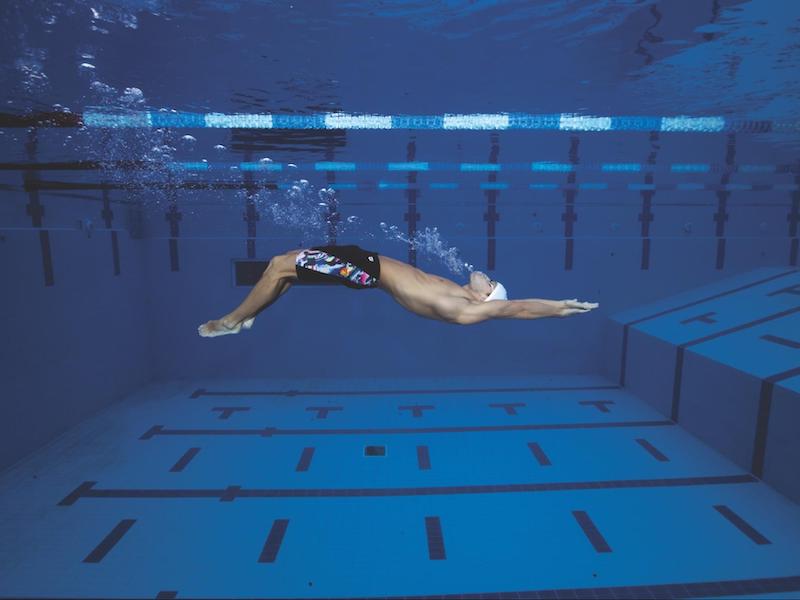
For this drill, you will perform the entire flip turn process. Start in the middle of the pool. Begin swimming toward the wall. Focus on all the mechanics mentioned above and perform a flip turn. Take extra care to plant your feet firmly on the wall with your knees bent, and give a strong kick-off into your streamline.
When you do this drill, approach the wall at a slow pace so you can focus on your mechanics. Start swimming slow at 50 percent race pace. Then, move on to 70, 80, 90, and 100 percent effort. You should feel comfortable performing flip turns at any speed at the end of this drill.
Common Flip Turn Mistakes
There are a few common mistakes to watch out for when performing backstroke and freestyle flip turns. These errors can slow you down and require more effort, but they are easily avoidable if you understand what to look for.
A good tip for training your flip turn is to set up a camera or have someone film you while you practice your technique. Watching your form is a great way to understand how your body is moving through motion so you can make adjustments if necessary.
Don’t Look Up
Many people want to look up at the wall as they approach it. While the urge may be strong to look and see how close that wall is, try your best to keep your head down and use the “T” on the swim line to let you know how close the wall is. Trust all the reps you’ve spent training your timing coming into the wall.
Don’t Slow Down
Many swimmers slow down as they come into the wall. Practice the swimming drills listed above so you can become comfortable with your timing, technique, and speed coming into a turn. Try to go into each turn at the same pace you swim the rest of your lap, as this will increase your turn speed.
Wait to Breath
Breathing right before and right after your turns will slow you down. Try to get your breathing timing and control down to the point where you can perform your whole turn sequence without taking a breath.
Don’t Skip the Flip Turn as an Open-Water Swimmer
Don’t skip learning the flip turn altogether because you mainly swim in open water! If you are a triathlete, you might think turning is a waste of time because most events are performed in open water. However, if you spend time training for triathlons in a pool, it is good to master the flip turn because it will better allow you to mimic the continuous feel of open-water swimming.
Dryland Training to Improve Your Flip Turns

Training outside the pool is another great way to improve strength and speed in your flip turns. In fact, cross-training can develop muscles in the entire body, decrease injury, and lower the chance of burnout. Below are a few exercises you can try to work out your legs and core muscles.
Squats are a staple exercise for all athletes. They will increase core and leg strength, which translates to faster turns. Perform squats with or without weight resistance. Jump squats are a great squat variation for developing the explosive power needed when you push off the wall.
Abdominal exercises like sit-ups, Russian twists, and planks can help you develop a strong core that will aid you when initiating your flip turn and throwing your legs over and against the wall.
Enjoy the Increased Speed of the Flip Turn
Now that you understand how to flip turn properly, it’s time to get to the swimming pool and practice these new swimming tips! Whether you swim the freestyle stroke or the backstroke, be sure to focus on your timing, proper somersault technique, and an excellent push-off and streamline into your next lap.
Need the right gear to get your training underway? Visit the arena store to be sure you have all your swim essentials, like goggles and swim caps, so you can train your best.
Written by:
Harrison Howarth
Harrison is a freelance writer with a background in competitive aquatic sports. His love for water polo and swim, combined with his passion for writing and education, drives him to continue teaching and inspiring individuals to participate in aquatics.
